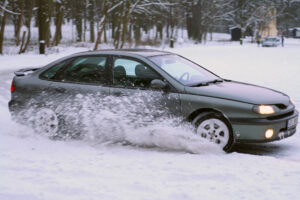Winter Driving Safety Tips
Essential Advice for a Safer Journey During the Winter Months
 As the winter months come, so do the potential dangers of winter driving. Snow, ice, wind, and low visibility can all make the roads treacherous. Knowing how to stay safe while driving during winter is essential for anyone wanting to avoid accidents.
As the winter months come, so do the potential dangers of winter driving. Snow, ice, wind, and low visibility can all make the roads treacherous. Knowing how to stay safe while driving during winter is essential for anyone wanting to avoid accidents.
Winter driving can be dangerous, but with the right safety tips, travelers can make it home safely. Here are some essential safety tips for winter driving. These tips will help you to avoid accidents and stay safe on the road this season.
Before You Hit the Road:
Make sure your vehicle is in good condition
Check all fluid levels, tires, brakes and lights to ensure that you are ready for the colder temperatures and increased hazards of winter roads. Pay special attention to tire pressure since cold weather causes tires to lose pressure more quickly than during warmer months.
Plan your route ahead of time
Even if you’re just going a short distance, plan your route. You’ll know where all of the services are located including hospitals, gas stations, and auto repair shops as well as rest stops along the way. Just in case you need a break or become stranded in bad weather.
Carry an emergency kit
Your emergency kit should have supplies like:
- flares or reflectors
- extra blankets
- warm clothes and boots
- food and water
- jumper cables
- a shovel
- sand/salt/cat litter for traction if needed
- cell phone charger and mobile phone in case of emergencies so you can call for help quickly if needed
During Your Drive:
Turn on headlights– day or night
When visibility is low due to fog or snow storms. This will make it easier for other drivers to see your vehicle on the road and avoid collisions with other vehicles or animals crossing paths unexpectedly due to poor visibility conditions.
Be aware of black ice
Black ice is difficult to see because it looks just like regular pavement – as well as freezing rain which makes roads slippery even after they appear dry following rainfall earlier in the day/night. When temperatures hover around freezing point, take extra care while driving over bridges or overpasses. These tend to freeze first due to their elevated height above ground level. Cold air settles at lower heights first before working its way up from ground level upwards throughout the night/day.
Don’t tailgate
Leave plenty of room between you and other vehicles. If someone does skid out ahead of you then there is enough time for them recover without any further danger posed by your vehicle being too close behind them . This also applies when driving on any type of roadway whether winter-specific hazardous conditions exist or not.
Also remember that stopping distances increase drastically in icy conditions. Meaning more time needs to be allowed between vehicles when traveling at speed due to decreased grip available on slippery surfaces. So maintain greater distances between vehicles than usual during wintery conditions, especially if visibility is reduced due to fog/snow storms etcetera.
Keep snow cleared off your car completely before driving
Don’t be “that driver” who clears off a piece of the windshield and heads down the road with a foot of snow piled up over the rest of their car. Or worse, clean the ice off of your windshied, but leave sheets of ice on your hood or roof top. These ice sheets then become ice missiles for other cars as you are driving down the road. You should never be in so much of a hurry that you endanger yourself and other drivers around you. If you do, we hope you have high auto insurance limits plus an umbrella insurance policy. You may find yourself needing them.
Take the time to properly clean your vehicle. This includes clearing off windows completely so that vision isn’t impaired, obscuring your view while turning corners etcetera. Plus remove any built-up snow from around mirrors & door openings (as blocking these areas prevents simple duties such as using indicators correctly). Also make sure your license plates aren’t covered up by compacted snow buildup either – otherwise you may get pulled over by the police.
Finally don’t rely on cruise control when driving in snowy conditions
Cruise control may seem convenient during trips through snowy terrain since it allows drivers keep consistent speeds. However, it should be avoided. Because accelerating too quickly (or slowing down too suddenly) can cause wheels spinning. This can potentially lead into skidding situations, which could ultimately result into being stuck nowhere fast unless! So turn off cruise control until reaching safer roads again please!
With these helpful tips in mind every driver should be able reduce risks associated with winter travel significantly while enjoying a great journey throughout colder months ahead!
